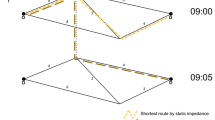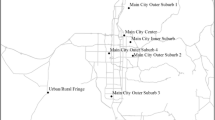Abstract
Transportation systems exist to improve individual accessibility. However, emerging applications of GIS in transportation (GIS-T) and intelligent transportation system (ITS) focus on throughput (the amount of system flow) rather than accessibility. Throughput is related but not equivalent to accessibility. Sensitive transportation planning requires rigorous, realistic and tractable accessibility measures. This paper reports on the development of GIS software that implement space-time accessibility measures (STAMs). The STAMs reflect the benefits that individuals receive from the transportation system. They are easily interpreted, particularly with respect to changes in accessibility. The STAMs also consider the locations and travel velocities dictated by the transportation system as well as individuals’ daily activity schedules. Tractable computational procedures allow calculation of the STAMs for detailed, urban-scale transportation networks. A prototype ArcInfo®-linked software system that runs on Windows NT® or Sun Solaris® platform implements the STAMs with user-friendly interfaces and project management tools.
Similar content being viewed by others
References
M. Ben-Akiva and S.R. Lerman. “Disaggregate Travel and Mobility-Choice Models and Measures of Accessibility,” in D.A. Hensher and P.R. S topher (Eds.), Behavioural Travel Modeling, Croom-Helm: London, 654–679, 1979.
M. Ben-Akiva and S.R. Lerman. Discrete Choice Analysis: Theory and Application to Travel Demand. MIT Press: Cambridge, MA, 1985.
D.E. Boyce, Y.-F. Zhang, and M.R. Lupa. “Introducing ‘feedback’ into four-step travel forecasting procedure versus equilibrium solution of combined model,” Transportation Research Record, Vol. 1443:65–74, 1994.
L.D. Burns. Transportation, Temporal, and Spatial Components of Accessibility. Lexington Books: Lexington, MA, 1979.
J.D. Coehlo and A.G. Wilson. “The optimum location and size of shopping centers,” Regional Studies, Vol. 10:413–421, 1976.
A.S. Fotheringham and M.E. O'Kelly. Spatial Interaction Models: Formulations and Applications. Kluwer Academic: Dordrecht, 1989.
S.C.M. Geertmann and J.R.R. Van Eck. “GIS and models of accessibility potential: An application in planning,” International Journal of Geographical Systems, Vol. 9:67–80, 1995.
S. Greaves and P. Stopher. “A synthesis of GIS and activity-based travel-forecasting,” Geographical Systems, Vol. 5:59–89, 1998.
T. HaÈ gerstrand. “Space-time and human conditions,” in A. Karlqvist, L. Lundqvist, and F. Snickars (Eds.), Dynamic Allocation of Urban Space. Saxon House: Teakfield, Farnborough, Hants, 3–12, 1975.
W.G. Hansen. “How accessibility shapes land use,” Journal of the American Institute of Planners, Vol. 25:73-76, 1959.
C.-I. Hsu and Y.-P. Hsieh. “Travel and Activity Choices Based on an Individual Accessibility Model.” Paper presented at the 36th annual meeting of the Western Regional Science Association, Big Island of Hawai'i, February 23-27, 1997.
M.-P. Kwan. “Space-time and integral measures of accessibility: A comparative analysis using a pointbased framework,” Geographical Analysis, Vol. 30:191–216, 1998.
D. McFadden. “Computing Willingness-to-Pay in Random Utility Models,” working paper, Department of Economics, University of California, Berkeley, 1995.
H.J. Miller. “Towards Consistent Travel Demand Estimation in Transportation Planning: A Guide to the Theory and Practice of Equilibrium Travel Demand Modeling,” Research Report, Bureau of Transportation Statistics, U. S. Department of Transportation. Available at http://www.bts.gov/tmip/papers/feedback/miller/ toc.htm, 1997.
H.J. Miller. “Measuring space-time accessibility benefits within transportation networks: Basic theory and computational procedures,” Geographical Analysis, Vol. 31:187–212, 1999.
J.M. Morris, P.L. Dumble, and M.R. Wigan. “Accessibility indicators for transport planning,” Transportation Research A, Vol. 13A:91–109, 1979.
A. Okabe and M. Kitamura. “A computational method for market area analysis on a network,” Geographical Analysis, Vol. 28:330–349, 1996.
J. Pooler. “Measuring geographical accessibility: A review of current approaches and problems in the use of population potentials,” Geoforum, Vol. 18:269–289, 1987.
K.A. Small. Urban Transportation Economics. Harwood Academic: Chur, Switzerland, 1992.
T.E. Smith. “A choice theory of spatial interaction,” Regional Science and Urban Economics, Vol. 5:137–176, 1975.
J.W. Weibull. “An axiomatic approach to the measurement of accessibility,” Regional Science and Urban Economics, Vol. 6:357–379, 1976.
J.W. Weibull. “On the numerical measurement of accessibility,” Environment and Planning A, Vol. 12:53–67, 1980.
H.C.W.L. Williams. “Travel demand models, duality relations and user benefit analysis,” Journal of Regional Science, Vol. 16:147–166, 1976.
H.C.W.L. Williams. “On the formation of travel demand models and economic evaluation measures of user benefit,” Environment and Planning A, Vol. 9:285–344, 1977.
H.C.W.L. Williams and M.L. Senior. “Accessibility, Spatial Interaction and the Spatial Benefit Analysis of Land Use-Transportation Plans,” in A. Karlqvist, L. Lundqvist, F. Snickars, and J.W. Weibull (Eds.), Spatial Interaction Theory and Planning Models. North-Holland: Amsterdam, 253–287, 1978.
A.G. Wilson. “Retailers' Profits and Consumers' Welfare in a Spatial Interaction Shopping Model,” in I. Masser (Ed.), Theory and Practice in Regional Science. London Papers in Regional Science 6, Pion: London, 42–57, 1976.
Author information
Authors and Affiliations
Rights and permissions
About this article
Cite this article
Miller, H.J., Wu, YH. GIS Software for Measuring Space-Time Accessibility in Transportation Planning and Analysis. GeoInformatica 4, 141–159 (2000). https://doi.org/10.1023/A:1009820006075
Issue Date:
DOI: https://doi.org/10.1023/A:1009820006075




